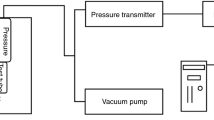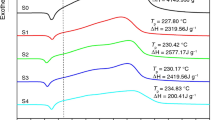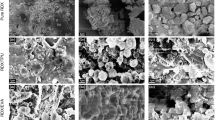Abstract
The thermal decomposition kinetic behavior of three HMX explosive samples containing 5.0 mass% (A-HMX) and 0.5 mass% RDX impurity (B-HMX) and HMX desensitized with 5.0 mass% paraffin wax (W-HMX) was studied by non-isothermal differential scanning calorimetric and thermogravimetric techniques at different temperature scan rates and by isothermal accelerated aging method. Using KAS isoconversional method, the mean activation energies of 229.36, 221.05, and 267.37 kJ mol−1 were obtained for B-HMX, A-HMX, and W-HMX, respectively, showing the higher thermal stability of pure and desensitized HMX. Moreover, the reaction mechanism was found in Avrami–Erofeev A2 model for all samples. In this study, by using the calculated kinetics triplets, the chemical lifetime of explosives were predicted based on 5.0 mass% mass loss and were compared with isothermal accelerated aging results, under two constant temperatures. The experimental results in the higher temperatures demonstrated relatively better consistency with predicted values.







Similar content being viewed by others
References
Fedoroff BT, Sheffield OE. Encyclopedia of explosives and related items, PATR 2700. Dover: Picatinny Arsenal; 1966.
Galante E, Haddad A, Marques N. Application of explosives in the oil industry. Int J Oil Gas Coal Eng. 2013;1(2):16–22.
Agrawal JP, Hodgson R. Organic chemistry of explosives. Hoboken, NJ: Wiley; 2007.
US Army, Detail Specification H. Military Standard MIL-DTL-45444C. US Department of Defence; 1996.
Van der Heijden AE, Bouma RH. Crystallization and Characterization of RDX, HMX, and CL-20. Cryst Growth Des. 2004;4(5):999–1007.
Hammer Johansen Ø, Digre Kristiansen J, Gjersøe R, Berg A, Halvorsen T, Smith KT, et al. RDX and HMX with reduced sensitivity towards shock initiation—RS-RDX and RS-HMX. Propellant Explos Pyrotech. 2008;33(1):20–4.
Shu-zhi H, Deng-Li L. Preparation and performance testing of reduced sensitivity-HMX. Shanxi Chem Ind. 2010;3:022.
Agrawal JP. High energy materials: propellants, explosives and pyrotechnics. Hoboken, NJ: Wiley; 2010.
Explosives M. Report TM-9-1300-214. Headquarters, Department of the Army; 1984.
Risse B, Schnell F, Spitzer D. Synthesis and desensitization of nano-β-HMX. Propellant Explos Pyrotech. 2014;39(3):397–401.
Y-b LI, H-j Huang, Huang H, S-b LI, L-f Guan. Desensitizing technology of high quality HMX by coating. Chin J Energy Mater. 2012;50:005.
Wu Y-Q, Huang F-L. Experimental investigations on a layer of HMX explosive crystals in response to drop-weight impact. Combust Sci Technol. 2013;185(2):269–92.
Peng D-J, Chang C-M, Chiu M. Thermal reactive hazards of HMX with contaminants. J Hazard Mater. 2004;114(1):1–13.
ASTM E. 698-05 Standard test method for arrhenius kinetic constants for thermally unstable materials using differential scanning calorimetry and the flynn. Wall/Ozawa Method; 2005.
Pouretedal HR, Damiri S, Ghaemi EF. Non-isothermal studies on the thermal decomposition of C4 explosive using the TG/DTA technique. Cent Eur J Energy Mater. 2014;11(3):405–16.
Burnham AK, Weese RK, Andrzejewski WJ. Kinetics of HMX and CP decomposition and their extrapolation for lifetime assessment. In: 36th International Annual Conference & 32nd International Pyrotechnics Seminar Karlruhe, Germany; 2005.
Vogelsanger B. Chemical stability, compatibility and shelf life of explosives. Chim Int J Chem. 2004;58(6):401–8.
Chiu MH, Prenner EJ. Differential scanning calorimetry: an invaluable tool for a detailed thermodynamic characterization of macromolecules and their interactions. J Pharm Bioallied Sci. 2011;3(1):39.
Yao M, Chen L, Yu J, Peng J. Thermoanalytical investigation on pyrotechnic mixtures containing Mg–Al alloy powder and barium nitrate. Procedia Eng. 2012;45:567–73.
Liao S-W, Hsieh C-C, Li K-Y, Tsai S-Y, Tseng J-M, Li J-S, et al. Storage lifetime management and thermal hazard assessment of thermally reactive material. J Therm Anal Calorim. 2014;116(1):205–14.
Vyazovkin S, Wight CA. Model-free and model-fitting approaches to kinetic analysis of isothermal and nonisothermal data. Thermochim Acta. 1999;340:53–68.
Chen G, Lee C, Kuo Y-L, Yen Y-W. A DSC study on the kinetics of disproportionation reaction of (hfac) Cu I (COD). Thermochim Acta. 2007;456(2):89–93.
Ribeiro B, Nohara L, Oishi S, Costa M, Botelho E. Nonoxidative thermal degradation kinetic of polyamide 6, 6 reinforced with carbon nanotubes. J Thermoplast Compos Mater. 2013;26(10):1317–31.
Han Y, Chen H, Liu N. New incremental isoconversional method for kinetic analysis of solid thermal decomposition. J Therm Anal Calorim. 2011;104(2):679–83.
Janković B, Mentus S, Janković M. A kinetic study of the thermal decomposition process of potassium metabisulfite: estimation of distributed reactivity model. J Phys Chem Solids. 2008;69(8):1923–33.
Vyazovkin S, Burnham AK, Criado JM, Pérez-Maqueda LA, Popescu C, Sbirrazzuoli N. ICTAC Kinetics Committee recommendations for performing kinetic computations on thermal analysis data. Thermochim Acta. 2011;520(1):1–19.
Pinheiro G, Lourenco V, Iha K. Influence of the heating rate in the thermal decomposition of HMX. J Therm Anal Calorim. 2002;67(2):445–52.
Lin C-P, Chang Y-M, Tseng J-M, Shu C-M. Comparisons of nth-order kinetic algorithms and kinetic model simulation on HMX by DSC tests. J Therm Anal Calorim. 2010;100(2):607–14.
Ordzhonikidze O, Pivkina A, Frolov Y, Muravyev N, Monogarov K. Comparative study of HMX and CL-20: thermal analysis, combustion and interaction with aluminium. J Therm Anal Calorim. 2011;105(2):529–34.
Li S, Jiang Z, Yu S. Thermal decomposition of HMX influenced by nano-metal powders in high energy fuel. Fuel Chem Div Prepr. 2002;47(2):596.
Liao L-Q, Yan Q-L, Zheng Y, Song Z-W, Li J-Q, Liu P. Thermal decomposition mechanism of particulate core-shell KClO3-HMX composite energetic material. Indian J Eng Mater Sci. 2011;18(5):393–8.
Tarver CM, Tran TD. Thermal decomposition models for HMX-based plastic bonded explosives. Combust Flame. 2004;137(1):50–62.
Yan Q-L, Zeman S, Zhao F-Q, Elbeih A. Noniso-thermal analysis of C4 bonded explosives containing different cyclic nitramines. Thermochim Acta. 2013;556:6–12.
Vyazovkin S. A unified approach to kinetic processing of non isothermal data. Int J Chem Kinet. 1996;28(2):95–101.
US Army. HMX (Cyclotetramethylenetetranitramine). MIL-H-45444B, Military specification. 1992.
US Army. Military Specification Wax, Desensitizing. MIL-W-20553D1976.
Vyazovkin S, Sbirrazzuoli N. Isoconversional kinetic analysis of thermally stimulated processes in polymers. Macromol Rapid Commun. 2006;27(18):1515–32.
Makhov M. In: Proceedings of the 36th international annual conference of ICT and 32nd international pyrotechnics seminar. 2005.
Brown ME, Dollimore D, Galwey AK. Reactions in the solid state. Amsterdam: Elsevier; 1980.
Giese B, Bamford CH, Tipper CFH, et al. Comprehensive chemical kinetics, Vol. 16, liquid‐phase oxidation, Elsevier, Amsterdam 1980. 264 Seiten, Preis: US $87.75. Ber Bunsenges Phys Chem. 1981;85(9):721–2.
Starink M. The determination of activation energy from linear heating rate experiments: a comparison of the accuracy of isoconversion methods. Thermochim Acta. 2003;404(1):163–76.
Ram IS, Singh K. Study of crystallization process in Se80In10Pb10 by iso-conversional methods. J Crys Process Technol. 2013;3:49–55.
Janković B. Kinetic analysis of the nonisothermal decomposition of potassium metabisulfite using the model-fitting and isoconversional (model-free) methods. Chem Eng J. 2008;139(1):128–35.
Georgieva V, Zvezdova D, Vlaev L. Non-isothermal kinetics of thermal degradation of chitosan. Chem Cent J. 2012;6(1):1–10.
Akbar J, Iqbal MS, Massey S, Masih R. Kinetics and mechanism of thermal degradation of pentose-and hexose-based carbohydrate polymers. Carbohydr Polym. 2012;90(3):1386–93.
Khawam A, Flanagan DR. Solid-state kinetic models: basics and mathematical fundamentals. J Phys Chem B. 2006;110(35):17315–28.
Akahira T, Sunose T. Method of determining activation deterioration constant of electrical insulating materials. Res Rep Chiba Inst Technol (Sci Technol). 1971;16:22–31.
Burnham AK, Weese RK. Thermal decomposition kinetics of HMX. Department of Energy: United States; 2005.
Singh G, Felix SP, Soni P. Studies on energetic compounds part 28: thermolysis of HMX and its plastic bonded explosives containing Estane. Thermochim Acta. 2003;399(1):153–65.
Acknowledgements
The authors wish to thank Malek Ashtar University of technology for supporting of this work.
Author information
Authors and Affiliations
Corresponding author
Rights and permissions
About this article
Cite this article
Sinapour, H., Damiri, S. & Pouretedal, H.R. The study of RDX impurity and wax effects on the thermal decomposition kinetics of HMX explosive using DSC/TG and accelerated aging methods. J Therm Anal Calorim 129, 271–279 (2017). https://doi.org/10.1007/s10973-017-6118-6
Received:
Accepted:
Published:
Issue Date:
DOI: https://doi.org/10.1007/s10973-017-6118-6




